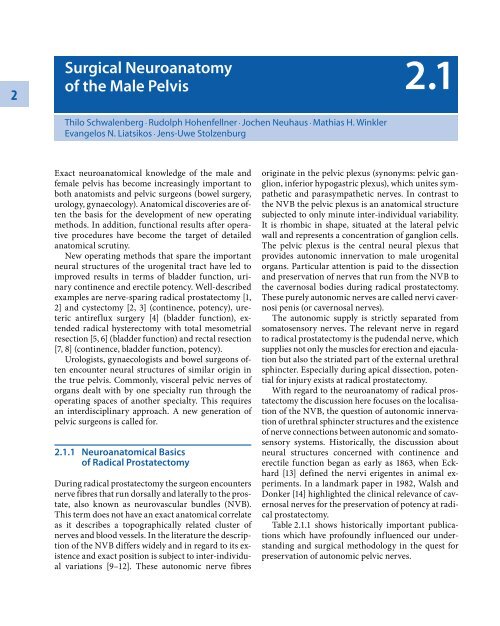7 - E-Lib FK UWKS
7 - E-Lib FK UWKS
7 - E-Lib FK UWKS
Create successful ePaper yourself
Turn your PDF publications into a flip-book with our unique Google optimized e-Paper software.
2<br />
Surgical Neuroanatomy<br />
of the Male Pelvis<br />
Thilo Schwalenberg ∙ Rudolph Hohenfellner ∙ Jochen Neuhaus ∙ Mathias H. Winkler<br />
Evangelos N. Liatsikos ∙ Jens-Uwe Stolzenburg<br />
Exact neuroanatomical knowledge of the male and<br />
female pelvis has become increasingly important to<br />
both anatomists and pelvic surgeons (bowel surgery,<br />
urology, gynaecology). Anatomical discoveries are often<br />
the basis for the development of new operating<br />
methods. In addition, functional results after operative<br />
procedures have become the target of detailed<br />
anatomical scrutiny.<br />
New operating methods that spare the important<br />
neural structures of the urogenital tract have led to<br />
improved results in terms of bladder function, urinary<br />
continence and erectile potency. Well-described<br />
examples are nerve-sparing radical prostatectomy [1,<br />
2] and cystectomy [2, 3] (continence, potency), ureteric<br />
antireflux surgery [4] (bladder function), extended<br />
radical hysterectomy with total mesometrial<br />
resection [5, 6] (bladder function) and rectal resection<br />
[7, 8] (continence, bladder function, potency).<br />
Urologists, gynaecologists and bowel surgeons often<br />
encounter neural structures of similar origin in<br />
the true pelvis. Commonly, visceral pelvic nerves of<br />
organs dealt with by one specialty run through the<br />
operating spaces of another specialty. This requires<br />
an interdisciplinary approach. A new generation of<br />
pelvic surgeons is called for.<br />
2.1.1 Neuroanatomical Basics<br />
2.1.1 of Radical Prostatectomy<br />
During radical prostatectomy the surgeon encounters<br />
nerve fibres that run dorsally and laterally to the prostate,<br />
also known as neurovascular bundles (NVB).<br />
This term does not have an exact anatomical correlate<br />
as it describes a topographically related cluster of<br />
nerves and blood vessels. In the literature the description<br />
of the NVB differs widely and in regard to its existence<br />
and exact position is subject to inter-individual<br />
variations [9–12]. These autonomic nerve fibres<br />
2.1<br />
originate in the pelvic plexus (synonyms: pelvic ganglion,<br />
inferior hypogastric plexus), which unites sympathetic<br />
and parasympathetic nerves. In contrast to<br />
the NVB the pelvic plexus is an anatomical structure<br />
subjected to only minute inter-individual variability.<br />
It is rhombic in shape, situated at the lateral pelvic<br />
wall and represents a concentration of ganglion cells.<br />
The pelvic plexus is the central neural plexus that<br />
provides autonomic innervation to male urogenital<br />
organs. Particular attention is paid to the dissection<br />
and preservation of nerves that run from the NVB to<br />
the cavernosal bodies during radical prostatectomy.<br />
These purely autonomic nerves are called nervi cavernosi<br />
penis (or cavernosal nerves).<br />
The autonomic supply is strictly separated from<br />
somatosensory nerves. The relevant nerve in regard<br />
to radical prostatectomy is the pudendal nerve, which<br />
supplies not only the muscles for erection and ejaculation<br />
but also the striated part of the external urethral<br />
sphincter. Especially during apical dissection, potential<br />
for injury exists at radical prostatectomy.<br />
With regard to the neuroanatomy of radical prostatectomy<br />
the discussion here focuses on the localisation<br />
of the NVB, the question of autonomic innervation<br />
of urethral sphincter structures and the existence<br />
of nerve connections between autonomic and somatosensory<br />
systems. Historically, the discussion about<br />
neural structures concerned with continence and<br />
erectile function began as early as 1863, when Eckhard<br />
[13] defined the nervi erigentes in animal experiments.<br />
In a landmark paper in 1982, Walsh and<br />
Donker [14] highlighted the clinical relevance of cavernosal<br />
nerves for the preservation of potency at radical<br />
prostatectomy.<br />
Table 2.1.1 shows historically important publications<br />
which have profoundly influenced our understanding<br />
and surgical methodology in the quest for<br />
preservation of autonomic pelvic nerves.











![SISTEM SENSORY [Compatibility Mode].pdf](https://img.yumpu.com/20667975/1/190x245/sistem-sensory-compatibility-modepdf.jpg?quality=85)





